Healthcare Duty of Care: Conflicts, Dilemmas, and Complaint Handling
VerifiedAdded on 2020/01/23
|5
|1886
|653
Report
AI Summary
This report examines the duty of care in healthcare settings, particularly focusing on professionals working with children and young people. It defines duty of care as a legal and ethical obligation to prioritize the safety, welfare, and interests of individuals within a healthcare environment. The report explores how duty of care contributes to safeguarding and protecting individuals through risk assessments and established procedures. It identifies potential conflicts and dilemmas that may arise between duty of care and individual rights, offering strategies for managing these challenges. The report also provides guidance on obtaining additional support and advice regarding conflicts and dilemmas, including resources like team members, line managers, family members, and specialists. Furthermore, it outlines effective procedures for responding to and handling complaints, emphasizing the importance of a structured approach and prompt action. The conclusion reinforces the significance of considering various aspects of healthcare practice, including duty of care, complaint handling, and conflict resolution, to ensure high-quality care.
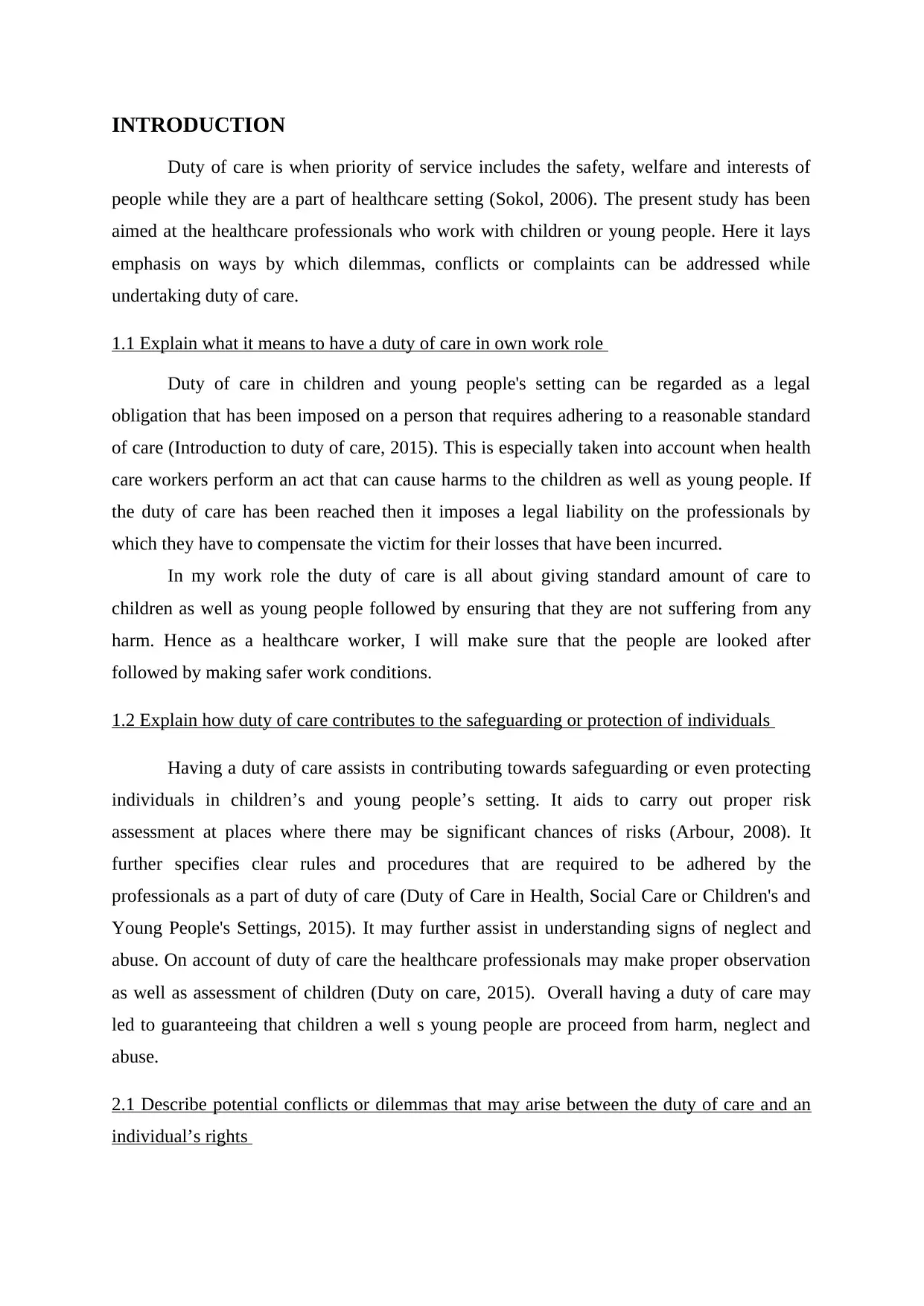
INTRODUCTION
Duty of care is when priority of service includes the safety, welfare and interests of
people while they are a part of healthcare setting (Sokol, 2006). The present study has been
aimed at the healthcare professionals who work with children or young people. Here it lays
emphasis on ways by which dilemmas, conflicts or complaints can be addressed while
undertaking duty of care.
1.1 Explain what it means to have a duty of care in own work role
Duty of care in children and young people's setting can be regarded as a legal
obligation that has been imposed on a person that requires adhering to a reasonable standard
of care (Introduction to duty of care, 2015). This is especially taken into account when health
care workers perform an act that can cause harms to the children as well as young people. If
the duty of care has been reached then it imposes a legal liability on the professionals by
which they have to compensate the victim for their losses that have been incurred.
In my work role the duty of care is all about giving standard amount of care to
children as well as young people followed by ensuring that they are not suffering from any
harm. Hence as a healthcare worker, I will make sure that the people are looked after
followed by making safer work conditions.
1.2 Explain how duty of care contributes to the safeguarding or protection of individuals
Having a duty of care assists in contributing towards safeguarding or even protecting
individuals in children’s and young people’s setting. It aids to carry out proper risk
assessment at places where there may be significant chances of risks (Arbour, 2008). It
further specifies clear rules and procedures that are required to be adhered by the
professionals as a part of duty of care (Duty of Care in Health, Social Care or Children's and
Young People's Settings, 2015). It may further assist in understanding signs of neglect and
abuse. On account of duty of care the healthcare professionals may make proper observation
as well as assessment of children (Duty on care, 2015). Overall having a duty of care may
led to guaranteeing that children a well s young people are proceed from harm, neglect and
abuse.
2.1 Describe potential conflicts or dilemmas that may arise between the duty of care and an
individual’s rights
Duty of care is when priority of service includes the safety, welfare and interests of
people while they are a part of healthcare setting (Sokol, 2006). The present study has been
aimed at the healthcare professionals who work with children or young people. Here it lays
emphasis on ways by which dilemmas, conflicts or complaints can be addressed while
undertaking duty of care.
1.1 Explain what it means to have a duty of care in own work role
Duty of care in children and young people's setting can be regarded as a legal
obligation that has been imposed on a person that requires adhering to a reasonable standard
of care (Introduction to duty of care, 2015). This is especially taken into account when health
care workers perform an act that can cause harms to the children as well as young people. If
the duty of care has been reached then it imposes a legal liability on the professionals by
which they have to compensate the victim for their losses that have been incurred.
In my work role the duty of care is all about giving standard amount of care to
children as well as young people followed by ensuring that they are not suffering from any
harm. Hence as a healthcare worker, I will make sure that the people are looked after
followed by making safer work conditions.
1.2 Explain how duty of care contributes to the safeguarding or protection of individuals
Having a duty of care assists in contributing towards safeguarding or even protecting
individuals in children’s and young people’s setting. It aids to carry out proper risk
assessment at places where there may be significant chances of risks (Arbour, 2008). It
further specifies clear rules and procedures that are required to be adhered by the
professionals as a part of duty of care (Duty of Care in Health, Social Care or Children's and
Young People's Settings, 2015). It may further assist in understanding signs of neglect and
abuse. On account of duty of care the healthcare professionals may make proper observation
as well as assessment of children (Duty on care, 2015). Overall having a duty of care may
led to guaranteeing that children a well s young people are proceed from harm, neglect and
abuse.
2.1 Describe potential conflicts or dilemmas that may arise between the duty of care and an
individual’s rights
Paraphrase This Document
Need a fresh take? Get an instant paraphrase of this document with our AI Paraphraser
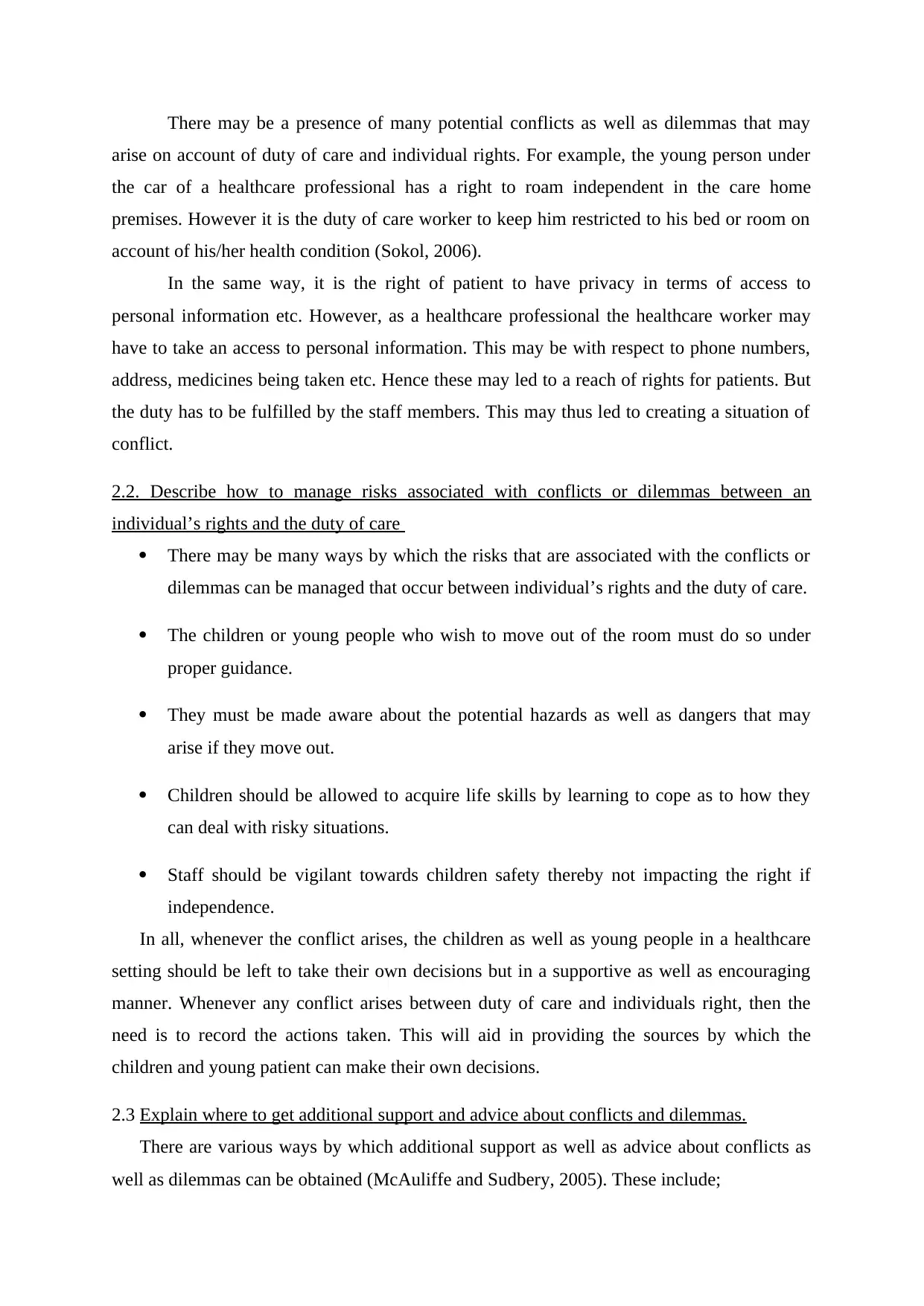
There may be a presence of many potential conflicts as well as dilemmas that may
arise on account of duty of care and individual rights. For example, the young person under
the car of a healthcare professional has a right to roam independent in the care home
premises. However it is the duty of care worker to keep him restricted to his bed or room on
account of his/her health condition (Sokol, 2006).
In the same way, it is the right of patient to have privacy in terms of access to
personal information etc. However, as a healthcare professional the healthcare worker may
have to take an access to personal information. This may be with respect to phone numbers,
address, medicines being taken etc. Hence these may led to a reach of rights for patients. But
the duty has to be fulfilled by the staff members. This may thus led to creating a situation of
conflict.
2.2. Describe how to manage risks associated with conflicts or dilemmas between an
individual’s rights and the duty of care
There may be many ways by which the risks that are associated with the conflicts or
dilemmas can be managed that occur between individual’s rights and the duty of care.
The children or young people who wish to move out of the room must do so under
proper guidance.
They must be made aware about the potential hazards as well as dangers that may
arise if they move out.
Children should be allowed to acquire life skills by learning to cope as to how they
can deal with risky situations.
Staff should be vigilant towards children safety thereby not impacting the right if
independence.
In all, whenever the conflict arises, the children as well as young people in a healthcare
setting should be left to take their own decisions but in a supportive as well as encouraging
manner. Whenever any conflict arises between duty of care and individuals right, then the
need is to record the actions taken. This will aid in providing the sources by which the
children and young patient can make their own decisions.
2.3 Explain where to get additional support and advice about conflicts and dilemmas.
There are various ways by which additional support as well as advice about conflicts as
well as dilemmas can be obtained (McAuliffe and Sudbery, 2005). These include;
arise on account of duty of care and individual rights. For example, the young person under
the car of a healthcare professional has a right to roam independent in the care home
premises. However it is the duty of care worker to keep him restricted to his bed or room on
account of his/her health condition (Sokol, 2006).
In the same way, it is the right of patient to have privacy in terms of access to
personal information etc. However, as a healthcare professional the healthcare worker may
have to take an access to personal information. This may be with respect to phone numbers,
address, medicines being taken etc. Hence these may led to a reach of rights for patients. But
the duty has to be fulfilled by the staff members. This may thus led to creating a situation of
conflict.
2.2. Describe how to manage risks associated with conflicts or dilemmas between an
individual’s rights and the duty of care
There may be many ways by which the risks that are associated with the conflicts or
dilemmas can be managed that occur between individual’s rights and the duty of care.
The children or young people who wish to move out of the room must do so under
proper guidance.
They must be made aware about the potential hazards as well as dangers that may
arise if they move out.
Children should be allowed to acquire life skills by learning to cope as to how they
can deal with risky situations.
Staff should be vigilant towards children safety thereby not impacting the right if
independence.
In all, whenever the conflict arises, the children as well as young people in a healthcare
setting should be left to take their own decisions but in a supportive as well as encouraging
manner. Whenever any conflict arises between duty of care and individuals right, then the
need is to record the actions taken. This will aid in providing the sources by which the
children and young patient can make their own decisions.
2.3 Explain where to get additional support and advice about conflicts and dilemmas.
There are various ways by which additional support as well as advice about conflicts as
well as dilemmas can be obtained (McAuliffe and Sudbery, 2005). These include;
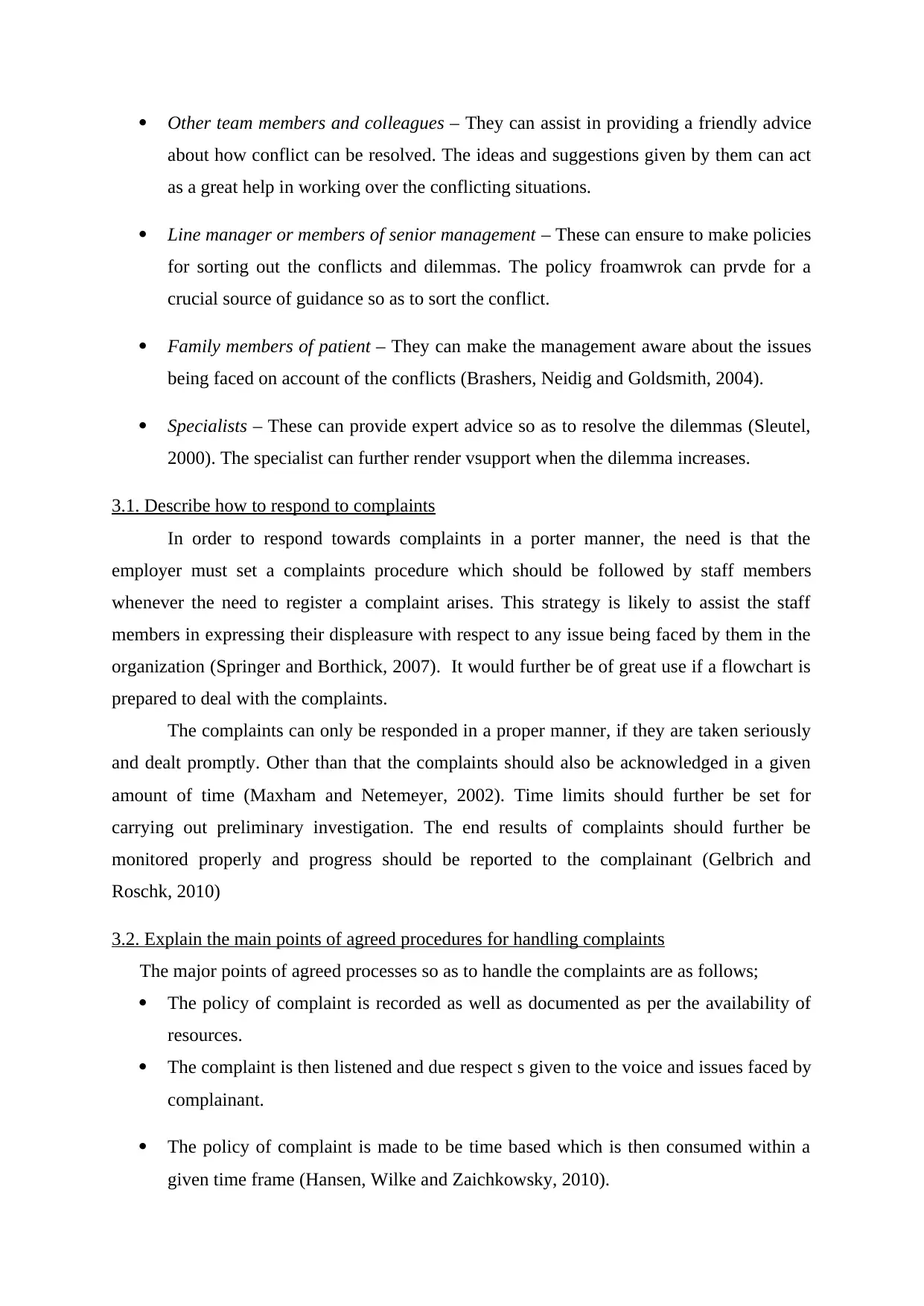
Other team members and colleagues – They can assist in providing a friendly advice
about how conflict can be resolved. The ideas and suggestions given by them can act
as a great help in working over the conflicting situations.
Line manager or members of senior management – These can ensure to make policies
for sorting out the conflicts and dilemmas. The policy froamwrok can prvde for a
crucial source of guidance so as to sort the conflict.
Family members of patient – They can make the management aware about the issues
being faced on account of the conflicts (Brashers, Neidig and Goldsmith, 2004).
Specialists – These can provide expert advice so as to resolve the dilemmas (Sleutel,
2000). The specialist can further render vsupport when the dilemma increases.
3.1. Describe how to respond to complaints
In order to respond towards complaints in a porter manner, the need is that the
employer must set a complaints procedure which should be followed by staff members
whenever the need to register a complaint arises. This strategy is likely to assist the staff
members in expressing their displeasure with respect to any issue being faced by them in the
organization (Springer and Borthick, 2007). It would further be of great use if a flowchart is
prepared to deal with the complaints.
The complaints can only be responded in a proper manner, if they are taken seriously
and dealt promptly. Other than that the complaints should also be acknowledged in a given
amount of time (Maxham and Netemeyer, 2002). Time limits should further be set for
carrying out preliminary investigation. The end results of complaints should further be
monitored properly and progress should be reported to the complainant (Gelbrich and
Roschk, 2010)
3.2. Explain the main points of agreed procedures for handling complaints
The major points of agreed processes so as to handle the complaints are as follows;
The policy of complaint is recorded as well as documented as per the availability of
resources.
The complaint is then listened and due respect s given to the voice and issues faced by
complainant.
The policy of complaint is made to be time based which is then consumed within a
given time frame (Hansen, Wilke and Zaichkowsky, 2010).
about how conflict can be resolved. The ideas and suggestions given by them can act
as a great help in working over the conflicting situations.
Line manager or members of senior management – These can ensure to make policies
for sorting out the conflicts and dilemmas. The policy froamwrok can prvde for a
crucial source of guidance so as to sort the conflict.
Family members of patient – They can make the management aware about the issues
being faced on account of the conflicts (Brashers, Neidig and Goldsmith, 2004).
Specialists – These can provide expert advice so as to resolve the dilemmas (Sleutel,
2000). The specialist can further render vsupport when the dilemma increases.
3.1. Describe how to respond to complaints
In order to respond towards complaints in a porter manner, the need is that the
employer must set a complaints procedure which should be followed by staff members
whenever the need to register a complaint arises. This strategy is likely to assist the staff
members in expressing their displeasure with respect to any issue being faced by them in the
organization (Springer and Borthick, 2007). It would further be of great use if a flowchart is
prepared to deal with the complaints.
The complaints can only be responded in a proper manner, if they are taken seriously
and dealt promptly. Other than that the complaints should also be acknowledged in a given
amount of time (Maxham and Netemeyer, 2002). Time limits should further be set for
carrying out preliminary investigation. The end results of complaints should further be
monitored properly and progress should be reported to the complainant (Gelbrich and
Roschk, 2010)
3.2. Explain the main points of agreed procedures for handling complaints
The major points of agreed processes so as to handle the complaints are as follows;
The policy of complaint is recorded as well as documented as per the availability of
resources.
The complaint is then listened and due respect s given to the voice and issues faced by
complainant.
The policy of complaint is made to be time based which is then consumed within a
given time frame (Hansen, Wilke and Zaichkowsky, 2010).
⊘ This is a preview!⊘
Do you want full access?
Subscribe today to unlock all pages.

Trusted by 1+ million students worldwide
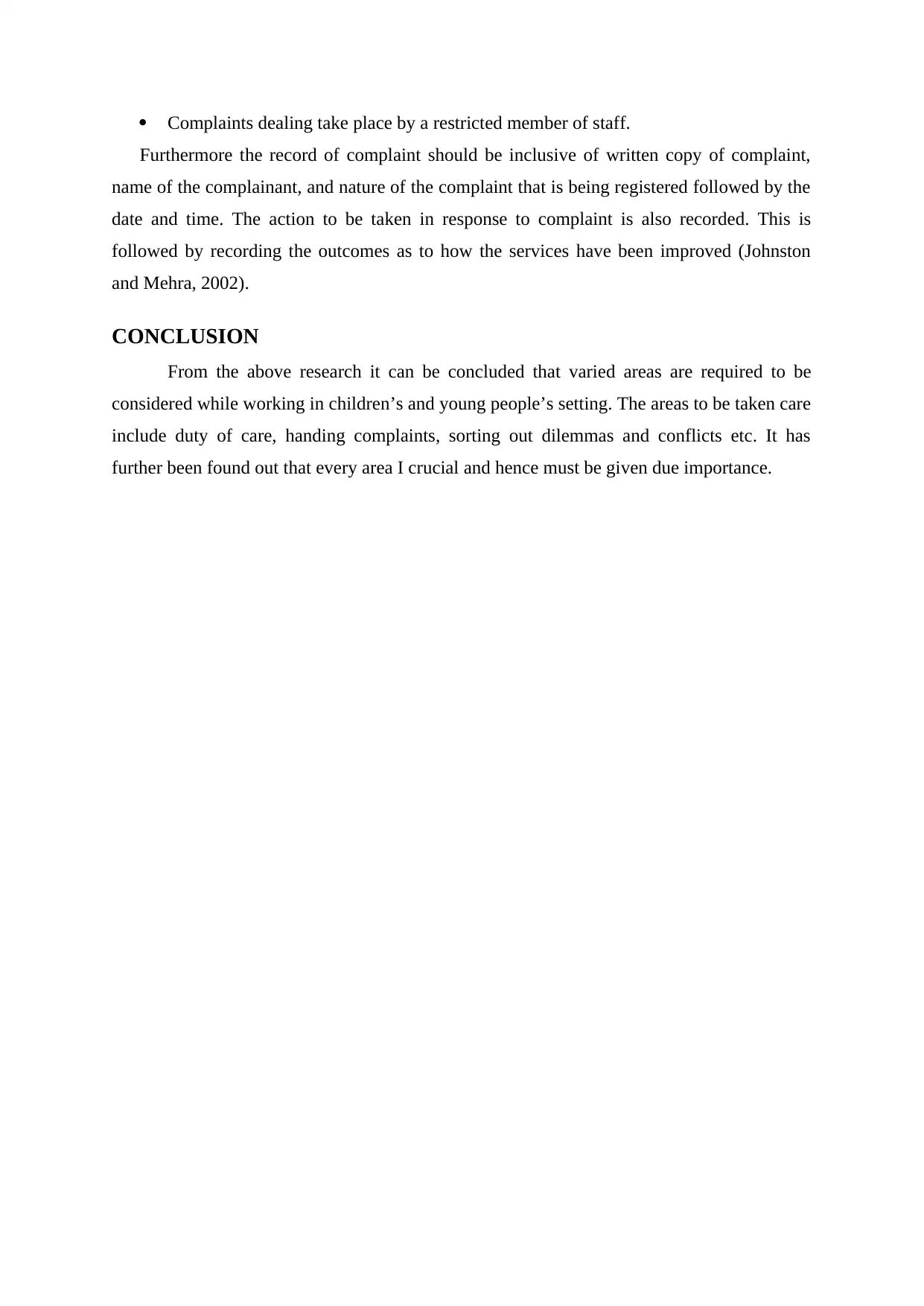
Complaints dealing take place by a restricted member of staff.
Furthermore the record of complaint should be inclusive of written copy of complaint,
name of the complainant, and nature of the complaint that is being registered followed by the
date and time. The action to be taken in response to complaint is also recorded. This is
followed by recording the outcomes as to how the services have been improved (Johnston
and Mehra, 2002).
CONCLUSION
From the above research it can be concluded that varied areas are required to be
considered while working in children’s and young people’s setting. The areas to be taken care
include duty of care, handing complaints, sorting out dilemmas and conflicts etc. It has
further been found out that every area I crucial and hence must be given due importance.
Furthermore the record of complaint should be inclusive of written copy of complaint,
name of the complainant, and nature of the complaint that is being registered followed by the
date and time. The action to be taken in response to complaint is also recorded. This is
followed by recording the outcomes as to how the services have been improved (Johnston
and Mehra, 2002).
CONCLUSION
From the above research it can be concluded that varied areas are required to be
considered while working in children’s and young people’s setting. The areas to be taken care
include duty of care, handing complaints, sorting out dilemmas and conflicts etc. It has
further been found out that every area I crucial and hence must be given due importance.
Paraphrase This Document
Need a fresh take? Get an instant paraphrase of this document with our AI Paraphraser
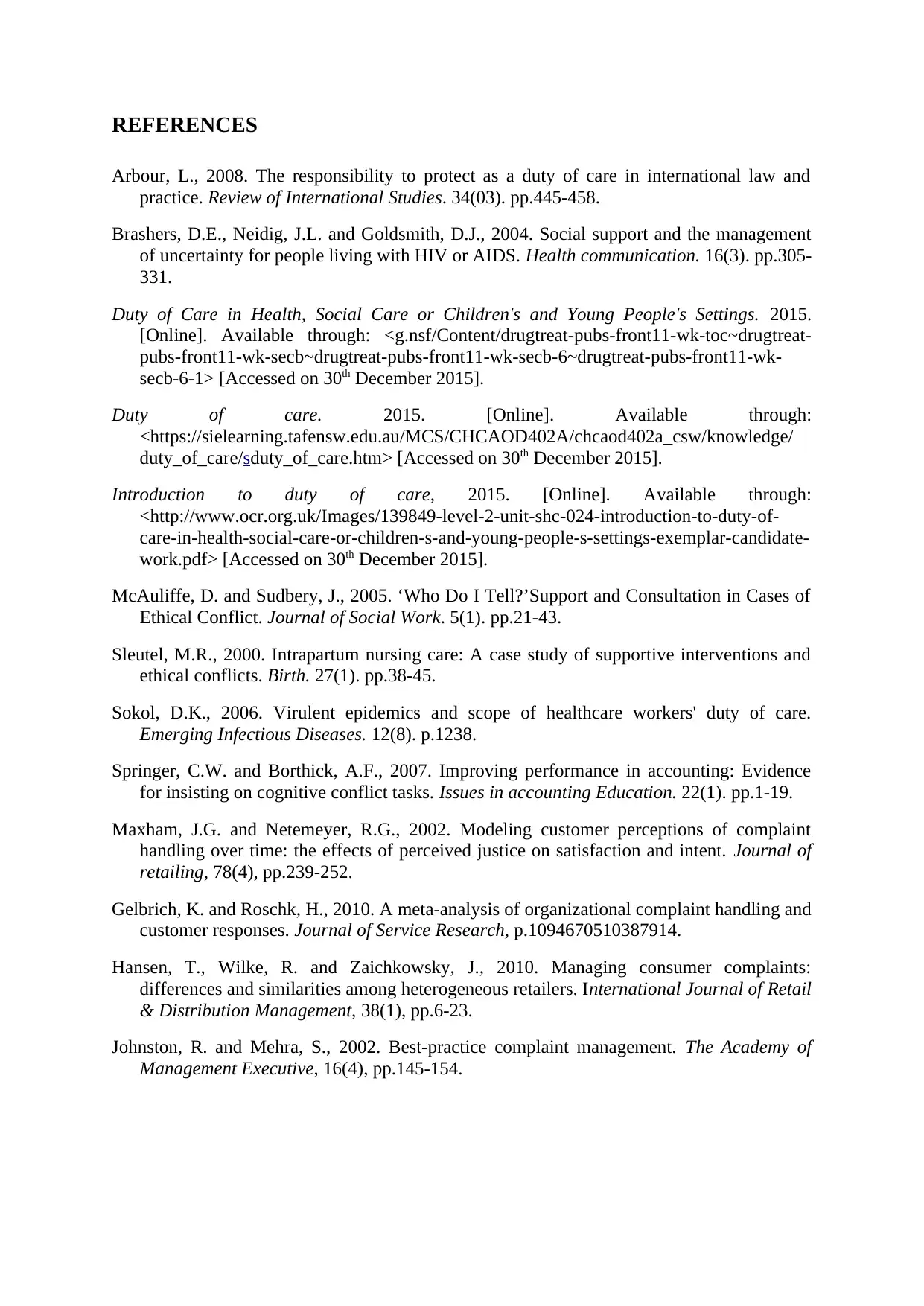
REFERENCES
Arbour, L., 2008. The responsibility to protect as a duty of care in international law and
practice. Review of International Studies. 34(03). pp.445-458.
Brashers, D.E., Neidig, J.L. and Goldsmith, D.J., 2004. Social support and the management
of uncertainty for people living with HIV or AIDS. Health communication. 16(3). pp.305-
331.
Duty of Care in Health, Social Care or Children's and Young People's Settings. 2015.
[Online]. Available through: <g.nsf/Content/drugtreat-pubs-front11-wk-toc~drugtreat-
pubs-front11-wk-secb~drugtreat-pubs-front11-wk-secb-6~drugtreat-pubs-front11-wk-
secb-6-1> [Accessed on 30th December 2015].
Duty of care. 2015. [Online]. Available through:
<https://sielearning.tafensw.edu.au/MCS/CHCAOD402A/chcaod402a_csw/knowledge/
duty_of_care/sduty_of_care.htm> [Accessed on 30th December 2015].
Introduction to duty of care, 2015. [Online]. Available through:
<http://www.ocr.org.uk/Images/139849-level-2-unit-shc-024-introduction-to-duty-of-
care-in-health-social-care-or-children-s-and-young-people-s-settings-exemplar-candidate-
work.pdf> [Accessed on 30th December 2015].
McAuliffe, D. and Sudbery, J., 2005. ‘Who Do I Tell?’Support and Consultation in Cases of
Ethical Conflict. Journal of Social Work. 5(1). pp.21-43.
Sleutel, M.R., 2000. Intrapartum nursing care: A case study of supportive interventions and
ethical conflicts. Birth. 27(1). pp.38-45.
Sokol, D.K., 2006. Virulent epidemics and scope of healthcare workers' duty of care.
Emerging Infectious Diseases. 12(8). p.1238.
Springer, C.W. and Borthick, A.F., 2007. Improving performance in accounting: Evidence
for insisting on cognitive conflict tasks. Issues in accounting Education. 22(1). pp.1-19.
Maxham, J.G. and Netemeyer, R.G., 2002. Modeling customer perceptions of complaint
handling over time: the effects of perceived justice on satisfaction and intent. Journal of
retailing, 78(4), pp.239-252.
Gelbrich, K. and Roschk, H., 2010. A meta-analysis of organizational complaint handling and
customer responses. Journal of Service Research, p.1094670510387914.
Hansen, T., Wilke, R. and Zaichkowsky, J., 2010. Managing consumer complaints:
differences and similarities among heterogeneous retailers. International Journal of Retail
& Distribution Management, 38(1), pp.6-23.
Johnston, R. and Mehra, S., 2002. Best-practice complaint management. The Academy of
Management Executive, 16(4), pp.145-154.
Arbour, L., 2008. The responsibility to protect as a duty of care in international law and
practice. Review of International Studies. 34(03). pp.445-458.
Brashers, D.E., Neidig, J.L. and Goldsmith, D.J., 2004. Social support and the management
of uncertainty for people living with HIV or AIDS. Health communication. 16(3). pp.305-
331.
Duty of Care in Health, Social Care or Children's and Young People's Settings. 2015.
[Online]. Available through: <g.nsf/Content/drugtreat-pubs-front11-wk-toc~drugtreat-
pubs-front11-wk-secb~drugtreat-pubs-front11-wk-secb-6~drugtreat-pubs-front11-wk-
secb-6-1> [Accessed on 30th December 2015].
Duty of care. 2015. [Online]. Available through:
<https://sielearning.tafensw.edu.au/MCS/CHCAOD402A/chcaod402a_csw/knowledge/
duty_of_care/sduty_of_care.htm> [Accessed on 30th December 2015].
Introduction to duty of care, 2015. [Online]. Available through:
<http://www.ocr.org.uk/Images/139849-level-2-unit-shc-024-introduction-to-duty-of-
care-in-health-social-care-or-children-s-and-young-people-s-settings-exemplar-candidate-
work.pdf> [Accessed on 30th December 2015].
McAuliffe, D. and Sudbery, J., 2005. ‘Who Do I Tell?’Support and Consultation in Cases of
Ethical Conflict. Journal of Social Work. 5(1). pp.21-43.
Sleutel, M.R., 2000. Intrapartum nursing care: A case study of supportive interventions and
ethical conflicts. Birth. 27(1). pp.38-45.
Sokol, D.K., 2006. Virulent epidemics and scope of healthcare workers' duty of care.
Emerging Infectious Diseases. 12(8). p.1238.
Springer, C.W. and Borthick, A.F., 2007. Improving performance in accounting: Evidence
for insisting on cognitive conflict tasks. Issues in accounting Education. 22(1). pp.1-19.
Maxham, J.G. and Netemeyer, R.G., 2002. Modeling customer perceptions of complaint
handling over time: the effects of perceived justice on satisfaction and intent. Journal of
retailing, 78(4), pp.239-252.
Gelbrich, K. and Roschk, H., 2010. A meta-analysis of organizational complaint handling and
customer responses. Journal of Service Research, p.1094670510387914.
Hansen, T., Wilke, R. and Zaichkowsky, J., 2010. Managing consumer complaints:
differences and similarities among heterogeneous retailers. International Journal of Retail
& Distribution Management, 38(1), pp.6-23.
Johnston, R. and Mehra, S., 2002. Best-practice complaint management. The Academy of
Management Executive, 16(4), pp.145-154.
1 out of 5
Related Documents
Your All-in-One AI-Powered Toolkit for Academic Success.
+13062052269
info@desklib.com
Available 24*7 on WhatsApp / Email
![[object Object]](/_next/static/media/star-bottom.7253800d.svg)
Unlock your academic potential
Copyright © 2020–2025 A2Z Services. All Rights Reserved. Developed and managed by ZUCOL.




